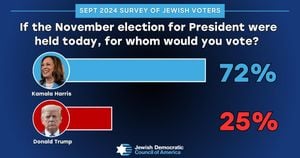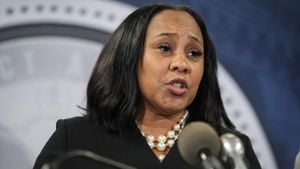With the 2024 US presidential election looming, Vice President Kamala Harris and former President Donald Trump stand at the forefront of their respective parties, each embodying starkly different visions for the nation's future. Both candidates are intensifying their campaigns with the November 5 voting day fast approaching, adding another layer of energy to what has already been a heated race.
Both Trump and Harris have been on the campaign trail, spreading their messages across key battleground states. Harris embarked on her last campaign dash through Michigan, making stops at various locations without directly mentioning Trump's name. Instead, she aimed to inspire hope and positivity among voters. Speaking at the Greater Emmanuel Institutional Church of God in Christ early on Sunday, November 3, she emphasized community solidarity and urged citizens to trust the democratic process. "We have the opportunity to finally turn the page on politics driven by fear and division," she declared, without directly naming Trump, who was campaigning simultaneously.
During her rally at Michigan State University, Harris engaged with students, urging them to bring their friends to the polls and reinforcing her belief in the electoral process. She expressed confidence in the voting system, stating, "I trust the elections we have and I trust the vote count" and urged those who could to vote, particularly urging those who hadn’t yet cast their ballots to do so without fear.
Across the political aisle, Trump was ramping up his rhetoric, particularly focusing on immigration and crime during his campaign. At a rally, he promised to impose 25% tariffs on all goods from Mexico and China if they failed to control fentanyl exports to the U.S., intertwining his domestic agenda with foreign policy. "We will immediately stop the drugs pouring across our border" was one of his promises. Trump's approach of tightening immigration policy includes proposals for mass deportations and reinstatement of strict border measures.
While Harris has focused on providing pathways to citizenship and supporting immigration reform, Trump’s platform echoes the policies he championed during his previous term, depicting stricter border security and more aggressive actions against illegal immigrants, which have drawn sharp contrasts between the candidates on one of the most contentious topics.
Economic policy is another battleground where the two have laid out differing visions. Harris has articulated her commitment to middle-class tax cuts and making permanent the expanded tax living credits initiated under Biden. She promoted investments aimed at combating climate change and bolstering renewable energy sources, which she sees as integral to creating jobs and addressing economic inequality.
On the other hand, Trump’s focus is on deregulation and the expansion of fossil fuel production, emphasizing his ambition to make the U.S. the cheapest place for energy production. He has signaled plans to roll back environmental regulations established under the current administration, instead promoting traditional energy resources like coal and oil as part of his strategy.
Environmental issues have also taken center stage, with Harris advocating for substantial federal investments to combat climate change—advocacy she strengthened during her time as California's former Attorney General. Her positioning aligns with the Biden Administration’s goal of cutting greenhouse gas emissions significantly by 2030, though critics have pointed to several setbacks and concerns about whether these goals can be met.
Trump’s stance on climate change is markedly different, often discarding scientific consensus about its urgency, and instead pushing for increased fossil fuel use. His quick dismissal of climate as "a hoax" complicates the dialogue around this pressing issue.
Foreign policy presents another stark divide between Harris and Trump, particularly concerning NATO and the current war between Ukraine and Russia. Harris has pledged continued support for Ukraine, aiming to reinforce the alliances built during Biden’s presidency, which she touts as necessary for maintaining global stability against Russian aggression. She has voiced her commitment to providing military and economic support to Ukraine, stressing the need for international unity.
Contrarily, Trump has expressed skepticism about the extent of U.S. involvement abroad. He has criticized the amount of aid being sent to Ukraine and has suggested he could have the conflict resolved before he even takes office again. His past comments have raised alarms among some allies who worry about his unpredictability, particularly on issues of military support and potential backing out from NATO commitments.
Ahead of the election, Harris and Trump are poised to shape America's future not only through their campaign promises but through the public perception of their leadership abilities. Polls have shown fluctuational support from voters, yet both candidates continue to target their messages toward key demographics, aiming for undecided voters as much as their bases.
Polls ticking closer to Election Day highlight the close nature of the race, with links established between voter turnout trends and potential outcomes. Early voting statistics show promising turnout among both candidates' supporters; Trump’s campaign seems to have made strides with Republican voters early due to mobilization efforts encouraging early casting.
Michigan, which boasts significant Electoral College votes, is proving to be pivotal ground, not only historically but electorally this year as well. Trump’s team has openly stated their belief they can reclaim the state by flipping swing voters who may be apprehensive about Harris’s policies.
Polling has also shifted, showing Harris gaining momentum heading closer to the election; notable trends highlighting her appeal could help define how the electoral map shapes up. With days left before voters cast their ballots, strategic campaigning is proving instrumental as both candidates vie for victory.
Trump’s campaign, meanwhile, has begun legal preparations for potential challenges to the election results, echoing the sentiments from the 2020 election. His explicit warnings about possible electoral malfeasance have received considerable attention and criticism, with Harris countering his assertions by reinforcing the strength of the electoral system and calling on voters to participate, emphasizing the importance of voting.
Both candidates present differing visions for America’s future, from the economy and border security to climate change and foreign policy, leaving voters to navigate between these distinct narratives as they prepare to make their voices heard this November. One thing is for certain: no matter who prevails, the impacts of this election will reverberate across numerous facets of American life, setting the stage for the years to come.
With the attention of the nation fixed squarely on November 5, and the stakes higher than ever, the choices made by millions of Americans will undoubtedly echo far beyond election night, shaping policy and direction for the U.S. as it steps forward.



